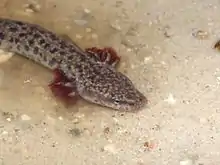| Western waterdog | |
|---|---|
 | |
| Scientific classification | |
| Domain: | Eukaryota |
| Kingdom: | Animalia |
| Phylum: | Chordata |
| Class: | Amphibia |
| Order: | Urodela |
| Family: | Proteidae |
| Genus: | Necturus |
| Species: | N. beyeri |
| Binomial name | |
| Necturus beyeri Viosca, 1937 | |
| Synonyms | |
|
Necturus lodingi Viosca, 1937 | |
The western waterdog (Necturus beyeri)[2] is a species of aquatic salamander in the family Proteidae. It is endemic to the deep South, where it occurs in Alabama, Louisiana, Mississippi, and Texas.[1]
Taxonomy
This may be a species complex that could be split into different taxa as research indicates;[3] the Apalachicola (N. moleri) and Escambia (N. mounti) waterdogs were split from this species in 2020; previously, they were all grouped together as the Gulf Coast waterdog.[2] It is closely related to Necturus alabamensis.[4]
Studies indicate that as currently defined, it comprises four lineages: the "Mobile" lineage (ranging from the Mobile River to the Biloxi River), the "Pearl" lineage (ranging from the Wolf River to the Pearl River), the "Pontchartrain" lineage (ranging from the Bayou Bonfouca in Louisiana to the Blind River), and the "Western" lineage (ranging from the Calcasieu River to the west fork of the San Jacinto River).[2][5]
Description
Adults are 6 to 8.5 inches (15 to 22 cm) in length. It is brown with light brown and black speckles. It exhibits neoteny, retaining its gills and larva-like tail into adulthood. It can be distinguished from N. moleri and N. mounti (formerly thought to be conspecific) by its comparatively larger size, heavier spotting, and the unstriped larvae with numerous white spots.[2][6]
Ecology
This species lives in streams with sandy bottoms. It remains on the substrate or burrows into it, sometimes hiding in debris.[4]
Individuals of both sexes move more during the colder months of the year and seem to use one site as a home area from which they occasionally exhibit long-distance movements.[7]
The female attaches its eggs to aquatic debris.[8]
References
- 1 2 IUCN SSC Amphibian Specialist Group (2014). "Necturus beyeri". IUCN Red List of Threatened Species. 2014: e.T59431A64726751. doi:10.2305/IUCN.UK.2014-3.RLTS.T59431A64726751.en. Retrieved 18 November 2021.
- 1 2 3 4 Guyer, Craig; Murray, Christopher; Bart, Henry L.; Crother, Brian I.; Chabarria, Ryan E.; Bailey, Mark A.; Dunn, Khorizon (17 January 2020). "Colour and size reveal hidden diversity of Necturus (Caudata: Proteidae) from the Gulf Coastal Plain of the United States". Journal of Natural History. 54 (1–4): 15–41. doi:10.1080/00222933.2020.1736677. ISSN 0022-2933. S2CID 216256350.
- ↑ NatureServe. 2015. Necturus beyeri. NatureServe Explorer Version 7.1. Retrieved 25 June 2016.
- 1 2 IUCN SSC Amphibian Specialist Group. 2014. Necturus beyeri. The IUCN Red List of Threatened Species 2014. Retrieved 25 June 2016.
- ↑ "Necturus beyeri Viosca, 1937 | Amphibian Species of the World". amphibiansoftheworld.amnh.org. Retrieved 16 December 2021.
- ↑ Gulf Coast Waterdog. Jacksonville Zoo.
- ↑ Brenes, Roberto, and Neil B. Ford. "Seasonality and Movements of the Gulf Coast Waterdog (Necturus Beyeri) in Eastern Texas". The Southwestern Naturalist, vol. 51, no. 2, 2006, pp. 152–156. JSTOR
- ↑ Necturus beyeri. AmphibiaWeb. 2016.
